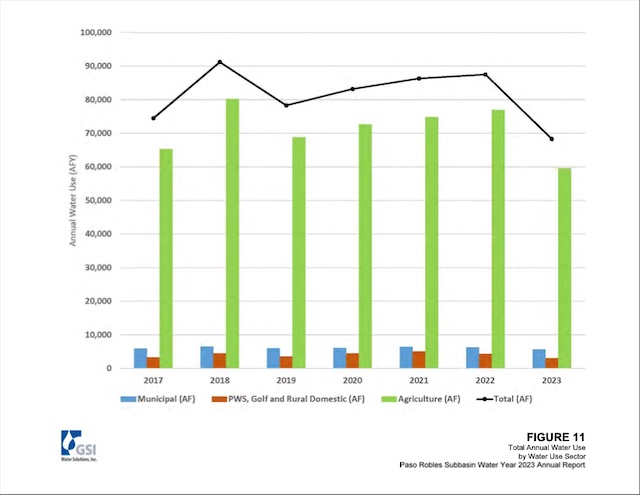Water basin report finds more water added during 2023

The Paso Robles Subbasin boundaries from the 2019 Paso Robles Subbasin Groundwater Sustainability Plan.
Basin remains ‘in a condition that needs to be improved’ says director of groundwater sustainability
– The draft version of the Paso Basin Annual Report for the 2023 water year was recently released to the community for comment, with the report now moving forward for approval by the Paso Basin Cooperative Committee. The report compiles information regarding trends affecting the Paso Robles Groundwater Basin, such as water use and storage capacity, from Oct. 1, 2022, to Sept. 30, 2023, and ongoing and future management plans.
The Paso Robles Groundwater Basin is a subbasin of the larger Salinas Valley Groundwater Basin and includes the Alluvial Aquifer and the Paso Robles Formation Aquifer. It drains into the Salinas River and further into the San Juan Creek, Estrella River, and Huer Huero Creek. The majority of inputs into the aquifers are from precipitation and surface water infiltration from natural water sources, whereas the majority of outputs are from well groundwater pumping, evapotranspiration, and discharge from streams.
“Some of the really important things that the general public should be aware of, first of all, almost everybody in the Paso Robles area and in the northern portion of San Luis Obispo County rely on groundwater as their primary source of water supply for their household needs [and] for their drinking water needs. We do get a little bit of supplemental water from the Nacimiento system but not much, so the vast majority of water coming out of somebody’s tap is groundwater,” said Director of Groundwater Sustainability for the County of San Luis Obispo Blaine T. Reely, “[the] Paso Robles Groundwater Basin is in a condition that needs to be improved. We have developed a plan to do that. We’re actively implementing that plan and we’re seeing the results of that work…thankfully, Mother Nature helped us a lot last winter…we’re certainly seeing a nice wet winter this year too. That’s going to continue to improve the conditions.”

The total annual usage of water from the Paso Robles Subbasin in previous years as seen in the draft annual report.
One finding in the report is that less water was pumped into the groundwater basin than in previous years due to a record rainfall in the 2023 water year. Over 93% of the water pumped out of the groundwater basin goes towards agricultural irrigation use for crops such as alfalfa, vegetables, vineyards, and more. The 2023 water year had a total groundwater extraction of 63,800 acre-feet compared to the 2022 water year of 83,200 acre-feet. This is the lowest amount extracted from the groundwater basin in the past six years.
Reely notes that the reason for the decreased extraction is “that we had a very wet winter [from] December 2022 through spring of 2023…a lot of that rainfall that didn’t run off into the streams and rivers found its way into the soil profile and then some of that even migrated further down into the aquifers and because of that, the moisture that was added through rainfall into the soil profile, that was moisture that the crops could use and didn’t need irrigation.”
The report also found that more groundwater was added into the groundwater basin in the 2023 water year, a finding that reversed the recent trend of groundwater loss. For the past three years, the annual loss of stored groundwater in the Paso Robles Formation Aquifer was 80,767 acre-feet in 2020, 41,458 acre-feet in 2021, and 117,051 acre-feet in 2022. The 2023 water year showed a gain in stored groundwater at 120,662 acre-feet.
Noted in the report is that the California Department of Water Resources approved the Paso Robles Subbasin Groundwater Sustainability Plan, which Reely said, “means we now have basically an officially approved road map to move forward and continue to move forward to our achieving sustainability in the basin.”
Reely notes that, “between us working on implementing projects and programs to reduce our reliance on groundwater in the volume of groundwater being pumped and help from Mother Nature, the conditions are getting better. We just want to continue that effort and it’s really important that we continue to inform the population that relies on that resource as to what’s going on and how they can be better informed and engaged.”
The California Department of Water Resources Sustainable Groundwater Management Grant Program awarded the county 7.6 million dollars in Feb. 2022; Reely had applied for 10 million dollars. One usage of the grant money during 2023 included bringing consultants on board for administrative and legal responsibilities.
“We’ve been using that 7.6 million dollars to do projects, to do engineering studies, to expand our monitoring network in the basin and to develop programs that will be used…to help reduce agricultural pumping in the basin…all of those things are now underway. It was a really positive year for the Paso basin [with] a lot of activity and conditions much improved,” Reely said.

Water use from the Paso Robles Subbasin as seen for urban, agricultural, and native vegetation and rural residential use.
Any public feedback that was received by March 15 will be considered in the final report, which will then move for approval to the Paso Basin Cooperative Committee on March 27. The Sustainable Groundwater Management Act requires the report to be submitted by April 1 to the California Department of Water Resources Groundwater Sustainability Plan portal.
“We’re really right at the very starting line of implementing our groundwater sustainability plan [and] the activities that need to happen to bring us into a sustainable condition. SGMA requires that we get the groundwater basin in a sustainable condition before the year 2040. When we got the plan submitted, we had 20 years to get that done. Now we’re three years into that 20-year period, we’re making progress [and are] very confident that we’re going to get there, but it’s important that the folks that live over the groundwater basin and use that groundwater are aware and cognizant of what’s happening and what they can do to stay engaged and be part of the solution,” Reely said.
Click here for a copy of the draft report.






















